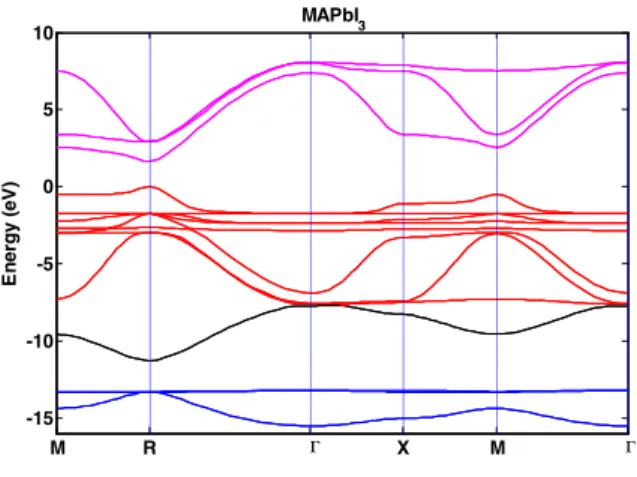HAL Id: hal-01341705
https://hal-insa-rennes.archives-ouvertes.fr/hal-01341705v2
Submitted on 26 Jan 2017
HAL is a multi-disciplinary open access
archive for the deposit and dissemination of
sci-entific research documents, whether they are
pub-lished or not. The documents may come from
teaching and research institutions in France or
abroad, or from public or private research centers.
L’archive ouverte pluridisciplinaire HAL, est
destinée au dépôt et à la diffusion de documents
scientifiques de niveau recherche, publiés ou non,
émanant des établissements d’enseignement et de
recherche français ou étrangers, des laboratoires
publics ou privés.
Tight binding modeling of halid perovskites
Soline Boyer-Richard, Reinhard Scholz, Jean-Marc Jancu, Claudine Katan,
Jacky Even
To cite this version:
Soline Boyer-Richard, Reinhard Scholz, Jean-Marc Jancu, Claudine Katan, Jacky Even. Tight binding
modeling of halid perovskites. 2è Journées Pérovskites Hybrides (JPH 2016), May 2016, Rennes,
France. �hal-01341705v2�
Tight binding modeling of halid perovskites
Soline Boyer-Richard
1, Reinhard Scholz
2, Jean-Marc Jancu
1, Claudine Katan
3, Jacky Even
11
Université Européenne de Bretagne, INSA, FOTON UMR 6082, 35708 Rennes, France
2
Institut für Angewandte Photophysik, TU Dresden, Deutschland
3
Institut des Sciences Chimiques de Rennes, UMR 6226, CNRS – Université de Rennes 1, France
The free-electron model is built upon the assumption that electrons propagate almost freely and that their wave functions can be approximated by plane waves. As an “opposite” starting point, one can use localized atomic orbitals as a basis set to perform band-structure calculations; this is the tight binding (TB) or linear combination of atomic orbitals (LCAO) approach. This method has been introduced for periodic crystals by Slater and Koster1 and was extensively used in the past to rationalize the physical properties of a wide range of compounds, from transition metals to semiconductor crystals2.
In this paper we use this approach to investigate the properties of HOP, considering the reference cubic structures of the 3D ABX3 family. Our tight-binding model is based on a 16 functions basis without SOC or a 32 functions basis
with SOC. For cubic ABX3 halide perovskites, we consider one “s” and three “p” orbitals for the B atom, and the
same for each of the three X atoms in the simple cubic unit cell, as already presented for a qualitative analysis of the band structure3. No basis function is taken into account for the A organic molecule, which’s position is not fixed because it has rotational degrees of freedom/disorder in the cubic phase. We only consider first neighbor interactions, only between B and X atoms. We have chosen the minimal sp3 basis as developed by Slater and Koster and we have tried to reproduce the already known experimental data like energy band-gap and effective masses around the bandgap with our semi-empirical TB model. Nine parameters are considered without SOC: four different diagonal matrix elements related to the atomic energies of the chemical constituents B and X: EsB, EpB, EsX
and EpX. Five transfer matrix elements refer to the overlap integral of atomic functions: Vss, VsBpX, VsXpB, Vppσ, Vppπ.
SOC only appears for p orbitals with two SOC values ΔsoB and ΔsoX. MAPbI3 dispersion relation has been calculated using the sp
3
tight binding method including SOC. Figure 1 presents the band diagram obtained, fitting existing experimental results recalled in ref. 2. The bandgap is obtained at R point with EG = 1.620 eV. Effective masses around the bandgap are the following: !"∗ = 0.235 !+ and !,∗=
0.229 !+. The dispersion relation shape is in very good agreement with the one presented by Brivio using DFT
calculation4 and with previous symmetry analyses5,6.
Figure 1. MAPbI3 band diagram obtained within the TB
scheme with SOC. The energy of valence band maximum is set to zero. Bands are colored according to their main orbital character: red depicts I 5p, pink depicts Pb 6p, black depicts Pb 6s and blue depicts I 5s. Points denoted M, X and R are zone-boundary points close to
(1/2,1/2,0), (1/2,0,0) and (1/2,1/2,1/2) respectively. The Γ point is the BZ center.
[1] Slater, J. C. & Koster, G. F. Phys. Rev. 94, 1498–1524 (1954).
[2] Jancu, J., Scholz, R., Beltram, F. & Bassani, F. Phys. Rev. B 57, 6493 (1998).
[3] Katan, C., Pedesseau, L., Kepenekian, M., Rolland, A. & Even, J. J. Mater. Chem. A, 3, 9232-9240 (2015). [4] Brivio, F., Butler, K. T., Walsh, A. & Van Schilfgaarde, M. Phys. Rev. B 89, 1–6 (2014).
[5] Even, J., Pedesseau, L. and Katan, C., J. Phys. Chem. C 118, 11566-11572 (2014). [6] Even, J., J. Phys. Chem. Lett. 6, 2238–2242 (2015).
M R X M -15 -10 -5 0 5 10 En e rg y ( e V ) MAPbI3 Γ Γ
